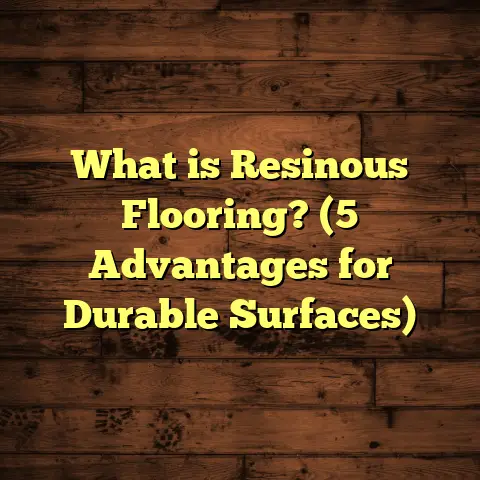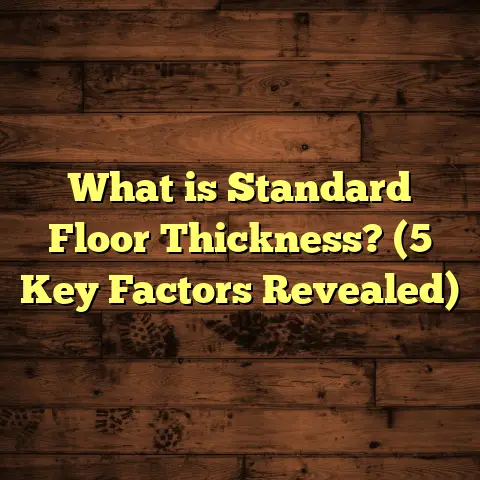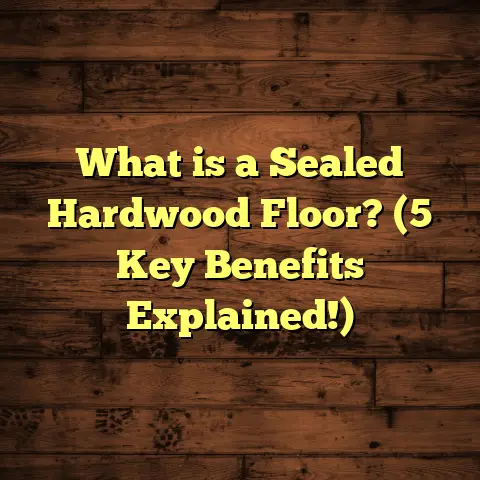What is Parquet Laminate Flooring? (5 Key Benefits Revealed!)
Imagine discovering a flooring option that feels like it was made just for your home—a solution that blends timeless charm with modern practicality and doesn’t break the bank. That’s exactly what happened to me when I first started working with parquet laminate flooring. It completely reshaped how I approach flooring projects, both for myself and my clients. Parquet laminate offers a unique blend of style, durability, and affordability that few other flooring options can match.
If you’ve ever admired those intricate parquet patterns but felt held back by the cost or maintenance, this article is going to open your eyes. I’ll walk you through everything I’ve learned about parquet laminate flooring over the years—sharing practical tips, real-life examples, and data-backed insights so you can make the best choice for your space.
What is Parquet Laminate Flooring?
Let’s start with the basics. Parquet laminate flooring is a type of laminate floor designed to imitate the look of traditional parquet wood floors. You know those classic floors made up of small wooden pieces arranged in decorative, geometric patterns? Think herringbone, chevron, basket weave, or brick-style layouts. These patterns have been around for centuries and bring a distinct elegance to any room.
Parquet laminate takes that classic patterning but uses modern laminate materials instead of solid hardwood. Laminate flooring itself is made of several layers: a high-density fiberboard core that gives it strength, a photographic layer that replicates wood grain or other textures, and a tough wear layer on top that protects it from scratches, stains, and moisture.
So, parquet laminate combines two things: the rich look of traditional parquet designs and the practical benefits of laminate construction. It’s a way to get that high-end look without the usual cost and upkeep associated with solid wood parquet.
Why I Got Interested in Parquet Laminate Flooring
When I first started in flooring, parquet was often seen as a luxury option—beautiful but expensive and delicate. Many clients loved the look but were worried about cost and maintenance. Then parquet laminate started gaining traction in the market, promising similar aesthetics with easier care.
I decided to give it a try on my own home renovation project. The process was surprisingly simple, and the end result blew me away. The floor looked authentic enough to fool most guests into thinking it was real wood. Since then, I’ve installed parquet laminate in dozens of homes and watched it become one of my favorite recommendations.
1. Affordable Elegance Without Sacrificing Style
One of the biggest reasons parquet laminate caught my attention—and why I keep recommending it—is the cost advantage. Real parquet flooring is beautiful but can be prohibitively expensive for many homeowners.
How Much Does Real Parquet Cost?
Traditional solid wood parquet typically costs between $15 and $30 per square foot just for materials. Installation adds another $10 to $20 per square foot because it’s labor-intensive work requiring precise cutting, fitting, and finishing. This means for 500 square feet, you could be looking at $12,500 to $25,000 or more.
Parquet Laminate Offers a Smarter Price Point
Parquet laminate materials usually fall between $3 and $7 per square foot. Installation costs are also lower since the planks or tiles come pre-finished and often use click-lock systems that float over underlayment without nails or glue. Labor for installation can run from $4 to $8 per square foot.
That brings your total average cost to roughly $7 to $15 per square foot—a fraction of traditional parquet costs.
Here’s a quick comparison to put things in perspective:
| Flooring Type | Material Cost (per sq ft) | Installation Cost (per sq ft) | Total Avg Cost (per sq ft) |
|---|---|---|---|
| Solid Wood Parquet | $15 – $30 | $10 – $20 | $25 – $50 |
| Parquet Laminate | $3 – $7 | $4 – $8 | $7 – $15 |
Personal Story: When Budget Meets Beauty
I once worked with a couple renovating their 1920s bungalow who adored the look of herringbone parquet floors. Their budget was tight due to other renovations needed in the house. We opted for parquet laminate instead of solid wood.
The results? They got the vintage charm they wanted but saved nearly 60% compared to real wood parquet. Plus, installation took only three days instead of over a week. They were thrilled—not only with how it looked but also with how much money they had left to spend on furniture and decor.
Actionable Tip: Set Your Budget Early
When planning new floors, figure out your maximum budget upfront. Then get quotes for both real parquet and parquet laminate so you can see the difference clearly. You might be surprised how much style you can afford with laminate without feeling like you’re settling.
2. Durability That Stands Up To Real Life
Durability is one area where many people worry about laminate floors compared to hardwood or engineered wood. But the truth about modern parquet laminate is that it can hold up surprisingly well—sometimes better than real wood—in busy households.
Why Is Parquet Laminate So Durable?
The secret lies in the wear layer. This top layer on laminate floors is typically made from melamine resin or aluminum oxide crystals that resist scratches, dents, scuffs, and stains. While hardwood can dent from dropped objects or pet claws, laminate resists damage more effectively.
Real-World Data on Wear Resistance
Laminate floors get assigned an AC (abrasion class) rating from 1 to 5:
- AC1 & AC2: Light residential use (bedrooms)
- AC3: General residential use (living rooms, kitchens)
- AC4: Heavy residential / moderate commercial use
- AC5: Heavy commercial use
For homes with kids or pets, I recommend choosing an AC3 or higher rating for your parquet laminate floor. This ensures it stays looking great even under heavy daily use.
A Case Study From My Work
One family I worked with has three kids under 10 and two energetic dogs. They wanted a floor that could survive spills, scratches from toys, and muddy paws.
We installed AC4-rated parquet laminate in their family room and hallway. After two years, their floors showed very minimal signs of wear—no deep scratches or dents at all. They told me it still looked brand new despite their active lifestyle.
Quick Tip: Protect High-Traffic Areas
Even durable floors benefit from some protection. Use felt pads on chair legs and consider area rugs in entryways or under dining tables to reduce abrasion in high-traffic spots.
3. Easy Installation Saves Time and Hassle
One thing I always tell clients is that time is money during renovations. The faster we can install floors without sacrificing quality, the better for everyone involved.
Why Parquet Laminate Installation Is Faster
Traditional parquet installation involves:
- Measuring and cutting small wood pieces precisely
- Nailing or gluing them down
- Sanding and finishing on-site
This can take weeks in larger spaces.
Parquet laminate comes as pre-finished planks or tiles designed for floating installation systems:
- They snap together easily with click-lock joints.
- No nails or glue are required.
- You lay them over an underlayment that cushions sound and moisture.
Because of this system, installation times are cut by nearly 40-50% compared to hardwood parquet in many cases.
My Experience On Site
In one large condo project with 700 square feet of living area, we installed traditional hardwood parquet on one floor and parquet laminate on another for comparison.
The hardwood job took 12 days including sanding and sealing.
The parquet laminate floor went down in just 6 days—ready to walk on immediately after installation.
Clients appreciated having minimal disruption while still getting that elegant parquet look.
Pro Install Tip: Prepare Your Subfloor Well
Good installation always starts below the surface. Make sure your subfloor is clean, dry, level within 3/16 inch over 10 feet (standard industry guideline), and free of debris before laying down underlayment and parquet laminate planks.
Uneven subfloors can cause creaks or damage later on.
4. Low Maintenance That Fits Busy Lifestyles
If you’re like me—or most homeowners—you want floors that don’t demand constant attention.
What Maintenance Does Parquet Laminate Need?
Compared to hardwood:
- No refinishing needed every few years.
- No special cleaning products required.
- Resistant to moisture stains if cleaned quickly.
Typical cleaning routine includes:
- Regular sweeping or vacuuming to remove dust and grit
- Wiping spills immediately with a damp cloth
- Occasional cleaning with manufacturer-approved laminate floor cleaner
Avoid soaking floors with water or using harsh chemicals like ammonia-based cleaners or bleach—they can degrade the protective wear layer over time.
How This Helped One Busy Family
I installed parquet laminate in a young couple’s rental property where tenants changed frequently. They appreciated how easy it was to keep floors clean between tenants without professional treatments or sanding.
It also resisted stains from accidental wine spills better than their previous hardwood floors did.
Quick Reminder: Don’t Use Wax or Polish
Unlike hardwood floors which sometimes benefit from polishing, waxes can leave residue on laminate floors causing dullness or uneven shine.
5. Variety of Designs That Match Any Home Style
Gone are the days when laminate flooring was limited to basic wood plank designs. Today’s parquet laminates come in countless styles, colors, textures, and patterns—making them incredibly adaptable to different home décors.
What Patterns Can You Get?
- Classic herringbone
- Chevron
- Basket weave
- Brick-style layouts
- Geometric repeats
You can find finishes ranging from:
- Light natural oak tones
- Warm cherry reds
- Dark walnut browns
- Gray-washed modern looks
- Even textured embossing to mimic hand-scraped wood
When helping clients choose patterns and finishes, I always recommend bringing samples home to see them in different lighting through the day—natural light changes color perception dramatically.
Personal Story: Helping Clients Pick Patterns
A couple renovating their kitchen couldn’t decide between two popular styles—traditional basket weave or modern chevron in gray tones. We laid down large sample boards in their actual space for a week so they could live with each option visually.
After seeing how natural sunlight reflected off each pattern during morning coffee and evening meals, they confidently chose chevron—feeling it gave their kitchen more energy and flow.
This small step prevented buyer’s remorse later on—something I encourage anyone unsure about pattern choices to do.
My Go-To Tool For Budgeting: FloorTally
Over time I realized one of the biggest headaches in flooring projects wasn’t just picking materials—it was estimating costs accurately upfront.
That’s when I started using FloorTally on nearly every project. It’s an online tool that helped me calculate realistic costs based on local labor rates and material prices while factoring in waste allowances (usually around 5-10%).
Here’s how FloorTally helped me:
- Saved time: Instead of juggling multiple spreadsheets or quotes from different suppliers, everything was consolidated.
- Experimented easily: I could swap out different patterns or brands within minutes to see how costs changed.
- Communicated clearly: Clients appreciated detailed cost breakdowns so they knew what they were paying for.
- Minimized surprises: Waste factors accounted for extra materials needed due to cuts or mistakes—something that often catches DIYers off guard.
Using this tool made me more confident budgeting projects—whether I was working solo or managing teams—and helped avoid overspending last minute.
Things To Watch Out For With Parquet Laminate Flooring
While I love recommending this flooring type for many situations, it’s fair to point out a few limitations:
- Not as warm underfoot as real wood: Some people prefer the natural warmth of hardwood; using underfloor heating or area rugs can help.
- Cannot be refinished: Once surface wear happens beyond repair, you’ll need replacement planks instead of sanding.
- Moisture sensitivity: While better than hardwood around moisture spills, laminate still isn’t ideal for very damp areas like full bathrooms.
If you have questions about these aspects or want recommendations tailored to specific rooms like kitchens or basements, feel free to ask!
Final Thoughts: Should You Choose Parquet Laminate Flooring?
If you want a floor that captures classic style without excessive cost or upkeep—and fits into a busy lifestyle—parquet laminate is tough to beat.
The balance of affordability, durability, quick installation, easy maintenance, and wide design options makes it my personal favorite recommendation when clients want something special yet practical.
Are you considering upgrading your floors soon? Have you tried parquet laminate before? Drop your questions or share your experiences—I’m here to help make your flooring journey smoother!





